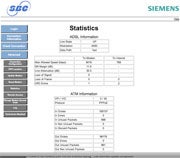3. Check Your Modem Parameters
 By rooting around in your modem's status screens, you can find such key pieces of information as signal-to-noise ratio and line attenuation, two determinants of line quality.While you're updating the firmware, check some key parameters. First, the maximum allowed speeds (both downstream and up) should match your service plan. If they don't, your ISP didn't set your service up properly. Give your ISP a call and ask it to fix the setup remotely.
By rooting around in your modem's status screens, you can find such key pieces of information as signal-to-noise ratio and line attenuation, two determinants of line quality.While you're updating the firmware, check some key parameters. First, the maximum allowed speeds (both downstream and up) should match your service plan. If they don't, your ISP didn't set your service up properly. Give your ISP a call and ask it to fix the setup remotely.Second, look for signal-to-noise ratio (or SN margin) and line attenuation, both measured in decibels (dB). The lower the signal-to-noise ratio, the more interference you have, and the greater the number of packets that will need to be re-sent because they didn't come through the first time. For this reason, a noisy line can dramatically cut throughput. Line attenuation measures the drop in voltage that comes with splitting the signal (especially for cable modems) and with long runs of cable or older wiring. Excessive signal loss will cause a drop in throughput.
For DSL modems, anything above about 50 dB for line attenuation is poor, and 20 to 30 dB is excellent. For signal-to-noise ratio, 7 to 10 dB is marginal, and 20 to 28 dB is excellent. My modem's SN margin registered at 12.5 dB, barely reaching the good range, and its line attenuation reading was 30.5 dB, which rates as very good. Note that acceptable ranges may vary depending on your service level and modem type (faster connections need to be cleaner), so check with your cable or DSL provider to see what numbers you should look for.
4. Troubleshooting Line Quality
If your off-peak Speedtest numbers didn't measure up to your plan's specifications, and if you found poor signal-to-noise or line attenuation numbers, it's time to troubleshoot your wiring. Excessive noise may cause intermittent dropouts, too.Your first task is to determine whether the signal is already degraded when it reaches your house or whether your own wiring is at fault. To test this, move your cable modem as close as you can to where the wire first splits. If possible, take a laptop and power cord for your modem outside to the junction where it connects to the house. Retest and see if things improve. If they don't, call your cable company. If your own wiring looks to be at fault, reduce the number of splits that occur before the wiring reaches your modem, and/or replace the wire itself, which may be faulty. The ultimate solution for cable modems is to create a split directly after the junction box, and then run a clean new cable directly to your modem, using the other split for all of your TVs (which are less affected by noise).
For DSL modems, noisy inside wiring tends to be due to the other phone equipment on your line. This interference is supposed to be controlled by the filters placed between the wall jack and each device. Make sure that they are all in place. If you still have too much noise, the best solution is to install a "DSL/POTS splitter' immediately after the phone box, where the wiring comes into the house, and then run a dedicated "homerun" wire straight to the modem. This arrangement will completely isolate your modem from the regular phone wiring--and the new wire should help too.
If you don't want to do this job yourself, you can ask your cable or phone company to perform both tasks for a fee.
Finally, improper grounding can be a source of noise, especially on cable. Make sure that all of your TV equipment is plugged into properly grounded outlets, with polarized plugs oriented in the right direction, and without any three-prong-to-two-prong adapters. If you have an electric outlet tester, use it to check for excess voltage on your cable wiring. An electrician can find and fix any grounding problems, which are safety concerns as well.
BACK | NEXT

No comments:
Post a Comment